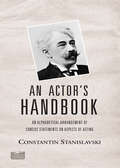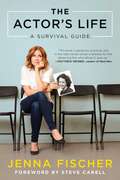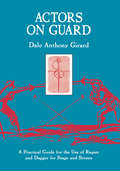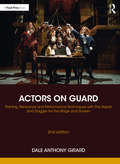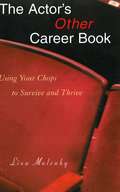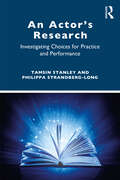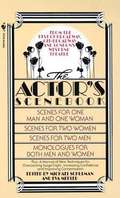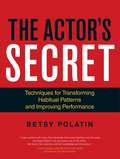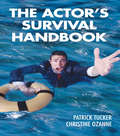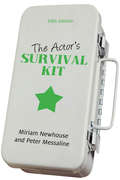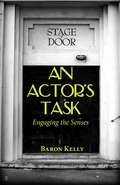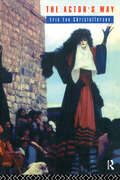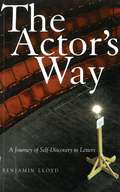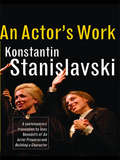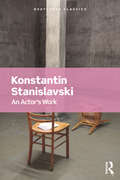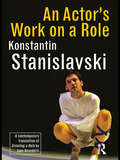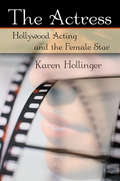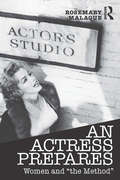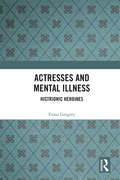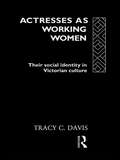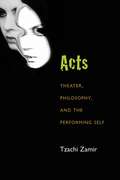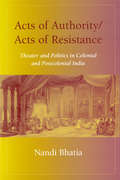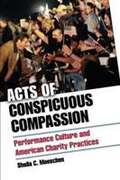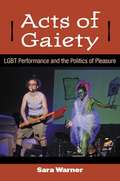- Table View
- List View
An Actor's Handbook: An Alphabetical Arrangement of Concise Statements on Aspects of Acting, Reissue of first edition
by Constantin Stanislavski Elizabeth Reynolds HapgoodThis is the classic lexicon of Stanislavski's most important concepts, all in the master's own words. Upon its publication in 1963, An Actor's Handbook quickly established itself as an essential guide for actors and directors. Culling key passages from Stanislavski's vast output, this book covers more than one hundred and fifty key concepts, among them 'Improvisation', 'External Technique', 'Magic If', 'Imaginary Objects', 'Discipline', 'What Is My System?' and 'Stage Fright'.This reissued, attractively packaged edition will be an essential book for any performer.
The Actor's Life: A Survival Guide
by Jenna FischerJenna Fischer's Hollywood journey began at the age of 22 when she moved to Los Angeles from her hometown of St. Louis. With a theater degree in hand, she was determined, she was confident, she was ready to work hard. So, what could go wrong? Uh, basically everything. The path to being a professional actor was so much more vast and competitive than she'd imagined. It would be eight long years before she landed her iconic role on The Office, nearly a decade of frustration, struggle, rejection and doubt. If only she'd had a handbook for the aspiring actor. Or, better yet, someone to show her the way—an established actor who could educate her about the business, manage her expectations, and reassure her in those moments of despair. Jenna wants to be that person for you. With amusing candor and wit, Fischer spells out the nuts and bolts of getting established in the profession, based on her own memorable and hilarious experiences. She tells you how to get the right headshot, what to look for in representation, and the importance of joining forces with other like-minded artists and creating your own work—invaluable advice personally acquired from her many years of struggle. She provides helpful hints on how to be gutsy and take risks, the tricks to good auditioning and callbacks, and how not to fall for certain scams (auditions in a guy's apartment are probably not legit—or at least not for the kind of part you're looking for!). Her inspiring, helpful guidance feels like a trusted friend who's made the journey, and has now returned to walk beside you, pointing out the pitfalls as you blaze your own path towards the life of a professional actor.
Actors on Guard: A Practical Guide for the Use of the Rapier and Dagger for Stage and Screen
by Dale Anthony GirardActors on Guard is the most comprehensive and detailed book on the art of theatrical swordplay available today. It provides the reader with the historical, theoretical and practical basis for learning, practicing and presenting theatrical sword fights. Focusing specifically on the Elizabethan rapier and dagger (the most popular weapons used in stage fights), Actors on Guard provides actors, directors, teachers, stage managers and technicians the skills and knowledge essential to presenting safe and effective fights, both for stage and screen.
Actors on Guard: Training, Rehearsal and Performance Techniques with the Rapier and Dagger for the Stage and Screen
by Dale Anthony GirardActors on Guard, Second Edition is the most comprehensive book covering the current practices in learning, rehearsing and performing safe and dynamic swordfights with the single rapier and the rapier and dagger for both stage and screen. Focusing specifically on the Elizabethan rapier and dagger – the most popular weapons used in stage fights – Actors on Guard provides actors, directors, teachers, stage managers and technicians the skills and knowledge essential to presenting safe and effective swordfights. The book takes the reader through the complex process of selecting safe stage weapons, learning the basic handling and management of the rapier and dagger, as well as how to safely move and interact in the potentially dangerous process of learning, rehearsing and performing choreographed swordplay. This new edition has been revised with current industry practices, featuring hundreds of step-by-step practical exercises in the care and handling of prop swords, footwork, guards, parries, cutting and thrusting techniques, blade taking actions, disarms, wounds and kills using the rapier and dagger, with revised diagrams and photographs. An excellent sourcebook for university stage combat classes as well as self-learners, Actors on Guard provides the reader with the historical, theoretical and practical basis for mastering the art of sword fighting for the stage and screen. The book includes access to a wealth of online resources, with additional information that expands upon specific mechanics, techniques and concepts covered in the text as well as some video demonstrations of solo and partnered techniques and exercises.
Actors on Guard: Training, Rehearsal and Performance Techniques with the Rapier and Dagger for the Stage and Screen
by Dale Anthony GirardActors on Guard, Second Edition is the most comprehensive book covering the current practices in learning, rehearsing and performing safe and dynamic swordfights with the single rapier and the rapier and dagger for both stage and screen.Focusing specifically on the Elizabethan rapier and dagger – the most popular weapons used in stage fights – Actors on Guard provides actors, directors, teachers, stage managers and technicians the skills and knowledge essential to presenting safe and effective swordfights. The book takes the reader through the complex process of selecting safe stage weapons, learning the basic handling and management of the rapier and dagger, as well as how to safely move and interact in the potentially dangerous process of learning, rehearsing and performing choreographed swordplay. This new edition has been revised with current industry practices, featuring hundreds of step-by-step practical exercises in the care and handling of prop swords, footwork, guards, parries, cutting and thrusting techniques, blade taking actions, disarms, wounds and kills using the rapier and dagger, with revised diagrams and photographs.An excellent sourcebook for university stage combat classes as well as self-learners, Actors on Guard provides the reader with the historical, theoretical and practical basis for mastering the art of sword fighting for the stage and screen.The book includes access to a wealth of online resources, with additional information that expands upon specific mechanics, techniques and concepts covered in the text as well as some video demonstrations of solo and partnered techniques and exercises.
The Actor's Other Career Book: Using Your Chops to Survive and Thrive
by Lisa MulcahyActors don't have to become Broadway stars to make a living with their acting talents. The Actor's Other Career Book pulls back the curtain to reveal more than 50 permanent and temporary positions available in cruise ships, trade shows, retail stores, advertising agencies, corporate settings, education, social outreach, tourist attractions, physical fitness, and much more. Whether actors are looking to continue performing in new venues or apply their skills to a new field, this is the resource to help make the transition. Interviews with successful actors reveal how others looked beyond the stage for lucrative and satisfying work, how they applied their training and background to their current positions, and how they achieved success on their own terms. A comprehensive listing of organizations, Web sites, companies, and publications provide a wealth of tools. All actors looking to take control of their futures will need this book.
An Actor’s Research: Investigating Choices for Practice and Performance
by Tamsin Stanley Philippa Strandberg-LongAn Actor’s Research: Investigating Choices for Practice and Performance presents an accessible and highly practical guide to the research approaches required of the actor. It aims to establish the precision and rigour of the actor’s craft that is intrinsic to a compelling acting performance, explore a range of research activities surrounding and emerging from practical work in the studio, and enable the actor to evolve a multifaceted skillset in researching for performance. The chapters focus on different research areas such as the self, character, relationships, circumstance, and context, providing accessible and practical guidance to developing a personal research practice. Each aspect is explained and engaged with as practice, rather than study – offering helpful hints and advising against common pitfalls – ultimately enabling the actor to locate the necessary knowledge to shape and inform their performance in both text-based and devised scenarios. Additionally, as the actor’s self is a personal instrument that is drawn on in terms of expression, impulses, and imagination; the self also becomes a source for creative appraisal and research. This book therefore offers comprehensive advice and strategies for self-evaluation and reflection, connecting research investigation with self-exploration in making expressive performance choices, making it a practice highly applicable to the actor’s needs. An Actor’s Research closely follows the training actor’s needs in terms of performance-based research; however, its practical research activities for text and character creation and strategies for the development of critical thinking and self-reflective skills support the ongoing development of the actor and their craft in both training and professional circumstances.
The Actor's Scenebook
by Michael Schulman Eva MeklerHere is wonderful, up-to-date material for scene study, selected from the best plays from recent theater seasons. More than 20 monologues for both men and women, carefully chosen to display the widest range of dramatic ability, are essential for auditioning actors. A large selection of parts for woman provide exciting opportunities to sharpen acting skills in roles that brought accolades from New York's toughest critics. More than 80 scenes in all, many previously unpublished, allow every actor, professional, amateur or student, to choose from either smart, sassy, often outrageous comedy or deeply moving drama--a unique, balanced collection of the most successful contemporary plays. 84 fully playable scenes with story notes. Monologues from the best new plays--including Agnes of God, Sly Fox, Key Exchange and Nuts. The best contemporary selection of scenes for women--more than 50 in all.
The Actor's Secret: Techniques for Transforming Habitual Patterns and Improving Performance
by Betsy PolatinOffering revolutionary new training for the actor, The Actor's Secret teaches actors and performers how to incorporate the fundamentals of the Alexander Technique, Somatic Experiencing®, and Breathing Coordination in order to reduce performance anxiety and stress; improve stage presence, breathing, and vocal production; and restore well-being and healthy functioning. These three kinesthetic disciplines are designed to lead to profound change and healing through body-mind reeducation. Part I explains in detail the principles of the three techniques. A practical method for self-improvement and neuromuscular reeducation, the Alexander Technique focuses on changing inefficient habits of movement and patterns of tension that inhibit the ability to move easily. Breathing Coordination helps increase breathing capacity and awareness. A method for resolving emotional trauma, Somatic Experiencing® follows a process of tracking bodily sensations to restore vitality and health. Enhanced with over 100 instructive photos, Parts II and III present explorations and exercises that draw on elements of the three methods. Topics covered include the importance of presence and non-doing; the proper mechanics of vocalization and singing; the understanding of character and role; and the actor's journey from auditions to performance, including initial script preparation, rehearsal, monologue, and scene work. Developed by Betsy Polatin, a movement specialist and master lecturer at Boston University's College of Fine Arts, the book's exercises provide the actor with simple tools for exploring his or her acting work. Most techniques and self-help books teach a new way of "doing." The secret of this book lies in "non-doing." When the actor learns to first recognize and then suspend habitual patterns, he or she opens the door to deeper artistic choices. "I have worked with many fine Alexander Technique teachers over the years and Betsy Polatin is far and away one of the finest. Her touch, her instincts, and her knowledge are miraculous."--Andre Gregory, actor and director, My Dinner with Andre
The Actor's Survival Handbook
by Patrick Tucker Christine OzanneWorried about short rehearsal time? Think that fluffing your lines will be the end of your career? Are you afraid you'll be typecast? Is there such a thing as acting too much? How should a stage actor adjust performance for a camera? And how should an actor behave backstage?The Actor's Survival Handbook gives you answers to all these questions and many more. Written with verve and humor, this utterly essential tool speaks to every actor's deepest concerns. Drawing upon their years of experience on stage, backstage, and with the camera, Patrick Tucker and Christine Ozanne offer forthright advice on topics from breathing to props, commitment to learning lines, audience response to simply landing the job in the first place. The book is rich with examples - both technical and inspirational. And because a director and an actor won't always agree, the two writers sometimes even offer alternative responses to a dilemma, giving the reader both an actor's take and a director's take on a particular point.Like Patrick Tucker's Secrets of Screen Acting, this new book is written with wit and passion, conveying the authors' powerful conviction that success is within every actor's grasp.
The Actor's Survival Kit: Fifth Edition
by Miriam Newhouse Peter MessalineThe Actor’s Survival Kit is required reading in Canadian theatre schools and is a constant resource for its many readers across the country. This fifth edition gives actors fresh research from today’s experience, new lists of Canada-wide contacts, and input from success stories. It speaks to a new generation of artists, giving them an up-to-date guide to the business of acting. The book addresses a range of new issues: performer websites, video self-production, and sending rmand networking on the Internet. It also takes a fresh look at old ones: agents, self-promotion, and work opportunities for women and minorities. The authors learn by constantly talking to emerging artists about the problems they face in the business in Canada. Often those conversations begin with, "You wrote the book!" The authors are still receiving thanks from grateful artists who have been guided by this irreplaceable book over the years.
An Actor's Task: Engaging the Senses
by Baron KellyAn Actor's Task provides a framework for studying the dual arts of acting: inhabiting a character both physically and psychologically. Actors at all levels can use this book to explore, develop, and review the sensory tools and training that enable them to be the best versions of themselves and, ultimately, to bring that understanding of "self" to their art. Innovative new exercises and selected classics--updated for today's students--comprise more than 100 exercises. Introductions to each exercise explain its aims and benefits. Clear step-by-step prompts provide guidance. Debriefing sections engage actors in reflection on what they have experienced and learned. This inspired text is equally suited to classroom use and individual study.
The Actor's Way
by Erik Exe ChristoffersenCan 'stage presence' be acquired? Why do some actors appear more dynamic in performance than others? In The Actors Way four experienced actors talk about the secrets and the practical realities of over twenty-five years of theatre training with Odin Teatret. Under the unique direction of Eugenio Barba, director of Odin Teatret, they have explored issues such as the connections between physical and mental work on stage, how to gain and control the spectator's attention, and intercultural performance techniques. The Actor's Way is a fascinating account of personal and professional development in the theatre. It will be vital reading for drama students and actors, but enjoyable and illuminating for anyone interested in the craft of acting.
The Actor's Way: A Journey of Self-Discovery in Letters
by Benjamin LloydThis is required reading for anyone passionate about the theater, acting, and the teaching of it. The struggles of a young actor, the actor/director relationship, the challenges of teaching art in universities, ageism, and techniques for teaching realistic acting are all communicated through a fictional series of letters between Andy, an anguished young New York City actor and Alice, his Quaker grade-school acting teacher.
An Actor's Work: A Student's Diary
by Konstantin StanislavskiStanislavski’s ‘system’ has dominated actor-training in the West since his writings were first translated into English in the 1920s and 30s. His systematic attempt to outline a psycho-physical technique for acting single-handedly revolutionized standards of acting in the theatre. Until now, readers and students have had to contend with inaccurate, misleading and difficult-to-read English-language versions. Some of the mistranslations have resulted in profound distortions in the way his system has been interpreted and taught. At last, Jean Benedetti has succeeded in translating Stanislavski’s huge manual into a lively, fascinating and accurate text in English. He has remained faithful to the author's original intentions, putting the two books previously known as An Actor Prepares and Building A Character back together into one volume, and in a colloquial and readable style for today's actors. The result is a major contribution to the theatre, and a service to one of the great innovators of the twentieth century.
An Actor's Work: A Student's Diary (Routledge Classics)
by Konstantin StanislavskiStanislavski’s ‘system’ has dominated actor-training in the West since his writings were first translated into English in the 1920s and 30s. His systematic attempt to outline a psycho-physical technique for acting single-handedly revolutionized standards of acting in the theatre. Until now, readers and students have had to contend with inaccurate, misleading and difficult-to-read English-language versions. Some of the mistranslations have resulted in profound distortions in the way his system has been interpreted and taught. At last, Jean Benedetti has succeeded in translating Stanislavski’s huge manual into a lively, fascinating and accurate text in English. He has remained faithful to the author's original intentions, putting the two books previously known as An Actor Prepares and Building A Character back together into one volume, and in a colloquial and readable style for today's actors. The result is a major contribution to the theatre, and a service to one of the great innovators of the twentieth century. This Routledge Classics edition includes a new Foreword by the director Richard Eyre.
An Actor's Work on a Role
by Konstantin StanislavskiAn Actor’s Work on a Role is Konstantin Stanislavski’s exploration of the rehearsal process, applying the techniques of his seminal actor training system to the task of bringing truth to one’s chosen role. Originally published over half a century ago as Creating a Role, this book was the third in a planned trilogy – after An Actor Prepares and Building a Character, now combined in An Actor’s Work – in which Stanislavski sets out his psychological, physical and practical vision of actor training. This new translation from renowned scholar Jean Benedetti not only includes Stanislavski’s original teachings, but is also furnished with invaluable supplementary material in the shape of transcripts and notes from the rehearsals themselves, reconfirming 'The System' as the cornerstone of actor training.
The Actress: Hollywood Acting and the Female Star
by Karen HollingerThe Actress: Hollywood Acting and the Female Star investigates the contemporary film actress both as an artist and as an ideological construct. Divided into two sections, The Actress first examines the major issues in studying film acting, stardom, and the Hollywood actress. Combining theories of screen acting and of film stardom, The Actress presents a synthesis of methodologies and offers the student and scholar a new approach to these two subjects of study.
An Actress Prepares: Women and "the Method"
by Rosemary Malague'Every day, thousands of women enter acting classes where most of them will receive some variation on the Stanislavsky-based training that has now been taught in the U.S. for nearly ninety years. Yet relatively little feminist consideration has been given to the experience of the student actress: What happens to women in Method actor training?' An Actress Prepares is the first book to interrogate Method acting from a specifically feminist perspective. Rose Malague addresses "the Method" not only with much-needed critical distance, but also the crucial insider's view of a trained actor. Case studies examine the preeminent American teachers who popularized and transformed elements of Stanislavsky’s System within the U.S.—Strasberg, Adler, Meisner, and Hagen— by analyzing and comparing their related but distinctly different approaches. This book confronts the sexism that still exists in actor training and exposes the gender biases embedded within the Method itself. Its in-depth examination of these Stanislavskian techniques seeks to reclaim Method acting from its patriarchal practices and to empower women who act. 'I've been waiting for someone to write this book for years: a thorough-going analysis and reconsideration of American approaches to Stanislavsky from a feminist perspective ... lively, intelligent, and engaging.' – Phillip Zarrilli, University of Exeter 'Theatre people of any gender will be transformed by Rose Malague’s eye-opening study An Actress Prepares... This book will be useful to all scholars and practitioners determined to make gender equity central to how they hone their craft and their thinking.' – Jill Dolan, Princeton University
Actresses and Mental Illness: Histrionic Heroines (Interdisciplinary Research in Gender)
by Fiona GregoryActresses and Mental Illness investigates the relationship between the work of the actress and her personal experience of mental illness, from the late nineteenth through to the end of twentieth century. Over the past two decades scholars have made great advances in our understanding of the history of the actress, unearthing the material conditions of her working life, the force of her creative agency and the politics of her reception and representation. By focusing specifically on actresses’ encounters with mental illness, Fiona Gregory builds on this earlier work and significantly supplements it. Through detailed case studies of both well-known and neglected figures in theatre and film history, including Mrs Patrick Campbell, Vivien Leigh, Frances Farmer and Diana Barrymore, it shows how mental illness – actual or supposed – has impacted on actresses’ performances, careers and celebrity. The book covers a range of topics including: representing emotion on stage; the ‘failed’ actress; actresses and addiction; and actresses and psychiatric treatment. Actresses and Mental Illness expands the field of actress studies by showing how consideration of the personal experience of the actress influences our understanding of her work and its reception. The book underscores how the actress can be perceived as a representative public woman, acting as a lens through which we can examine broader attitudes to women and mental illness.
Actresses as Working Women: Their Social Identity in Victorian Culture (Gender in Performance)
by Tracy C. DavisUsing historical evidence as well as personal accounts, Tracy C. Davis examines the reality of conditions for `ordinary' actresses, their working environments, employment patterns and the reasons why acting continued to be such a popular, though insecure, profession. Firmly grounded in Marxist and feminist theory she looks at representations of women on stage, and the meanings associated with and generated by them.
Acts: Theater, Philosophy, And The Performing Self
by Tzachi ZamirWhy do people act? Why are other people drawn to watch them? How is acting as a performing art related to role-playing outside the theater? As the first philosophical study devoted to acting, Acts: Theater, Philosophy, and the Performing Self sheds light on some of the more evasive aspects of the acting experience— such as the import of the actor's voice, the ethical unease sometimes felt while embodying particular sequences, and the meaning of inspiration. Tzachi Zamir explores acting’s relationship to everyday role-playing through a surprising range of examples of “lived acting,” including pornography, masochism, and eating disorders. By unearthing the deeper mobilizing structures that underlie dissimilar forms of staged and non-staged role-playing, Acts offers a multi-layered meditation on the percolation from acting to life. The book engages questions of theatrical inspiration, the actor’s “energy,” the difference between acting and pretending, the special role of repetition as part of live acting, the audience and its attraction to acting, and the unique significance of the actor’s voice. It examines the embodied nature of the actor’s animation of a fiction, the breakdown of the distinction between what one acts and who one is, and the transition from what one performs into who one is, creating an interdisciplinary meditation on the relationship between life and acting.
Acts of Authority/Acts of Resistance: Theater and Politics in Colonial and Postcolonial India
by Nandi BhatiaDespite its importance to literary and cultural texts of resistance, theater has been largely overlooked as a field of analysis in colonial and postcolonial studies. Acts of Authority/Acts of Resistance seeks to address that absence, as it uniquely views drama and performance as central to the practice of nationalism and anti-colonial resistance. Nandi Bhatia argues that Indian theater was a significant force in the struggle against oppressive colonial and postcolonial structures, as it sought to undo various schemes of political and cultural power through its engagement with subjects derived from mythology, history, and available colonial models such as Shakespeare. Bhatia's attention to local histories within a postcolonial framework places performance in a global and transcultural context. Drawing connections between art and politics, between performance and everyday experience, Bhatia shows how performance often intervened in political debates and even changed the course of politics. One of the first Western studies of Indian theater to link the aesthetics and the politics of that theater, Acts of Authority/Acts of Resistance combines in-depth archival research with close readings of dramatic texts performed at critical moments in history. Each chapter amplifies its themes against the backdrop of specific social conditions as it examines particular dramatic productions, from The Indigo Mirror to adaptations of Shakespeare plays by Indian theater companies, illustrating the role of theater in bringing nationalist, anticolonial, and gendered struggles into the public sphere.
Acts of Conspicuous Compassion: Performance Culture and American Charity Practices
by Moeschen Sheila C."Acts of Conspicuous Compassion" investigates the relationship between performance culture and the cultivation of charitable sentiment in America, exploring the distinctive practices that have evolved to make the plea for charity legible and compelling. From the work of 19th-century melodramas to the televised drama of transformation and redemption in reality TV s "Extreme Makeover: Home Edition," "Acts of Conspicuous Compassion" charts the sophisticated strategies employed by various charity movements responsible for making organized benevolence alluring, exciting, and seemingly uncomplicated. Sheila C. Moeschen brokers a new way of accounting for the legacy and involvement of disabled people within charity specifically, the articulation of performance culture as a vital theoretical framework for discussing issues of embodiment and identity dislodges previously held notions of the disabled existing as passive, objects of pity. This work gives rise to a more complicated and nuanced discussion of the participation of the disabled community in the charity industry, of the opportunities afforded by performance culture for disabled people to act as critical agents of charity, and of the new ethical and political issues that arise from employing performance methodology in a culture with increased appetites for voyeurism, display, and complex spectacle. "
Acts of Gaiety: LGBT Performance and the Politics of Pleasure
by Sara WarnerActs of Gaiety explores the mirthful modes of political performance by LGBT artists, activists, and collectives that have inspired and sustained deadly serious struggles for revolutionary change. The book explores antics such as camp, kitsch, drag, guerrilla theater, zap actions, rallies, manifestos, pageants, and parades alongside more familiar forms of "legitimate theater. " Against queer theory's long-suffering romance with mourning and melancholia and a national agenda that urges homosexuals to renounce pleasure if they want to be taken seriously by mainstream society, Acts of Gaiety seeks to reanimate notions of "gaiety" as a political value for LGBT activism. The book mines the archives of lesbian-feminist activism of the 1960s-70s, highlighting the outrageous gaiety that lay at the center of the social and theatrical performances of the era and uncovering original documents long thought to be lost. Juxtaposing historical figures such as Valerie Solanas and Jill Johnston with more recent performers and activists (including Hothead Paisan, Bitch & Animal, and the Five Lesbian Brothers), Warner shows how reclaiming this largely discarded and disavowed past elucidates possibilities for being and belonging. Acts of Gaiety explores the mutually informing histories of gayness as politics and as joie de vivre, along with the centrality of liveliness to queer performance and protest.
